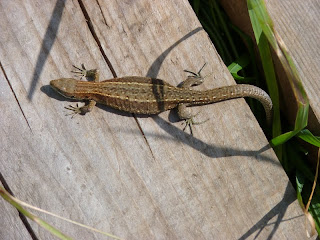Our latest Bedford RSPB trip was to Thursley Common in Surrey.
Sadly this site is not quite what it used to be since the devastating fire that wiped out most of the Heathland in 2006.
Dartford Warblers have yet to recolonise the site, so our best birds had to be 3 Woodlarks, one of which landed in a tree above our heads and gave us a version of its notable song, a Hobby, a family of Spotted Flycatchers and several family parties of Stonechats.
Juvenile Stonechat
Thursley is noted for it's insect population, in particular Dragonflies, and I'm told we saw Emperor, Keeled and Black-tailed Skimmers, Brown Hawkers and several others.
Keeled Skimmer
An interested insect that is present at Thursley is the Beewolf. This is a large member of the wasp family that preys on Honey Bees. It paralyses them with it's sting before carrying them off to it's burrow where it's eggs are laid on it's helpless victim. The hatched larvae then feast on the still living Bee. I did see some carrying Bees around, but this one is empty-handed. Click on the photo to see how ferocious it looks.
Beewolf
Lizards are very common at this site and many of the Common type were encountered , especially on the boardwalks over the marshland, including lots of young ones and several pregnant females.
Sadly this site is not quite what it used to be since the devastating fire that wiped out most of the Heathland in 2006.
Dartford Warblers have yet to recolonise the site, so our best birds had to be 3 Woodlarks, one of which landed in a tree above our heads and gave us a version of its notable song, a Hobby, a family of Spotted Flycatchers and several family parties of Stonechats.
Juvenile Stonechat
Thursley is noted for it's insect population, in particular Dragonflies, and I'm told we saw Emperor, Keeled and Black-tailed Skimmers, Brown Hawkers and several others.
Keeled Skimmer
An interested insect that is present at Thursley is the Beewolf. This is a large member of the wasp family that preys on Honey Bees. It paralyses them with it's sting before carrying them off to it's burrow where it's eggs are laid on it's helpless victim. The hatched larvae then feast on the still living Bee. I did see some carrying Bees around, but this one is empty-handed. Click on the photo to see how ferocious it looks.
Beewolf
Lizards are very common at this site and many of the Common type were encountered , especially on the boardwalks over the marshland, including lots of young ones and several pregnant females.
pregnant Common Lizard
On our way home we decided to take a look at Staines Reservoirs.
A lot of waterfowl were seen but most were Mallards and Coots.Scanning through these we did find some Tufted Duck, a few Pochard, 3 Shoveler, a couple of juvenile Shelduck, a fly-through Common Sandpiper and the best bird of the day a smashing summer plumaged Black-necked Grebe.





No comments:
Post a Comment